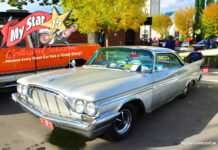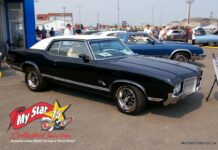People often give me their old car magazines because I work for MyStar, so I look at that as an opportunity to learn more about the vast world of old iron.
Someone gave me a copy of an unnamed (they know who they are) high-end car magazine about past and present European cars.
I had flings with Euro cars in high school, so they’re not like Martians to me, but the British writers were the best part about this magazine.
Jerry Sutherland
They own the English language, so they have every right to use it any way they want. This magazine was a great example of that because these guys were almost poetic in how they described a Land Rover Series 1.

This is what one writer said about driving the old Land Rover: “Down the other side, letting the drivetrain do the work with just the smallest tickle of the accelerator to get round the corner at the bottom and then we’re onto the flat—a term used loosely as we drive through the rut created by many who have gone before us”.
North American guys would have summed it up like this—” I used the torque and low gear to safely go down the hill”.
Then there was this gem: “The 80in handles all of this with aplomb. It gets on with it with a nonchalance that comes from decades of knowing it’s the best at what it does”.
That’s colorful–there are millions of Jeep owners who might disagree about that best part—but the text sure has impact.

Here’s how another guy summed up driving an Alfa Romeo 1900 “With that in mind, you marvel at the suppleness of the ride plus the 1900’s assured stride through the corners as the steering lightens and feels pleasingly firm and direct.”
You could put that copy in a sales brochure.

This example took it to the next level: ”The interior is similarly austere with the cloth seats favoured in more genteel Italian Berlinas and a dashboard that has the typically stripped-down aesthetic of 1950s European saloons”.
Put this man on your high-end auto sales team.
The writers also tested two 80s-era European cars in a comparison run.
Their Peugot 205 Rallye driving experience was summed up this way “The Rallye is an almost frenetic device, changing direction almost instantly.”. That’s a next-level way to say it handles great.

The Citroen AX GTG road test description was equally colorful.

This is what he learned: “It is surprisingly soft and compliant, the Citroen philosophy of soft spring rates and long wheel travel holding good”. That’s another well-researched way to say it has good road manners.
They did a rare op-ed on a 1966 Toronado because this magazine is all Euro.

Here’s how he summed up the first time he saw a ’66 Toronado when he was kid: “The Toronado owner’s wife had a gold Pagoda SL; the remote farmhouse they lived in was furnished with chic white lounge chairs and deep-pile lambswool rugs: plus they had a matching Afghan hound, which all suggested a certain loucheness to me, even aged four”.
I’ll admit—I had to look up ‘loucheness’. Trust me—it wasn’t complimentary. But what I really learned from his op-ed was this guy wasn’t really a Detroit iron guy. He just wanted to pretend he liked what he called ‘Yank’ cars.
The final piece was about auto designer Steve Harper.
This one was written straight out of the standard mystery novel playbook—this is how he described Steve: “He stares unblinkingly before breaking into a smile, and not for the first time”.

Here’s how he described Steve’s experiences with major car builders: “It was at this juncture that he became aware of the sort of political machinations that typify conglomerates”. Simply stated; Steve had problems with the pencil pushers.
I liked how they did things at this magazine.
Their British style was colorful and entertaining, but I’d never copy it because North Americans are straight-ahead people–plus I lost my dictionary.
Jerry Sutherland
By: Jerry Sutherland
Jerry Sutherland is a veteran automotive writer with a primary focus on the collector car hobby. His work has been published in many outlets and publications, including the National Post, Calgary Herald, Edmonton Journal, Ottawa Citizen, Montreal Gazette, Saskatoon StarPhoenix, Regina Leader-Post, Vancouver Sun and The Truth About Cars. He is also a regular contributor to Auto Roundup Publications.
- CLICK HERE TO SIGN UP FOR THE NEWSLETTER
- CLICK HERE to Like us on Facebook
- CLICK HERE to Follow us on Twitter
- CLICK HERE to Follow us on Pinterest
Please re-post this if you like this article.
























































